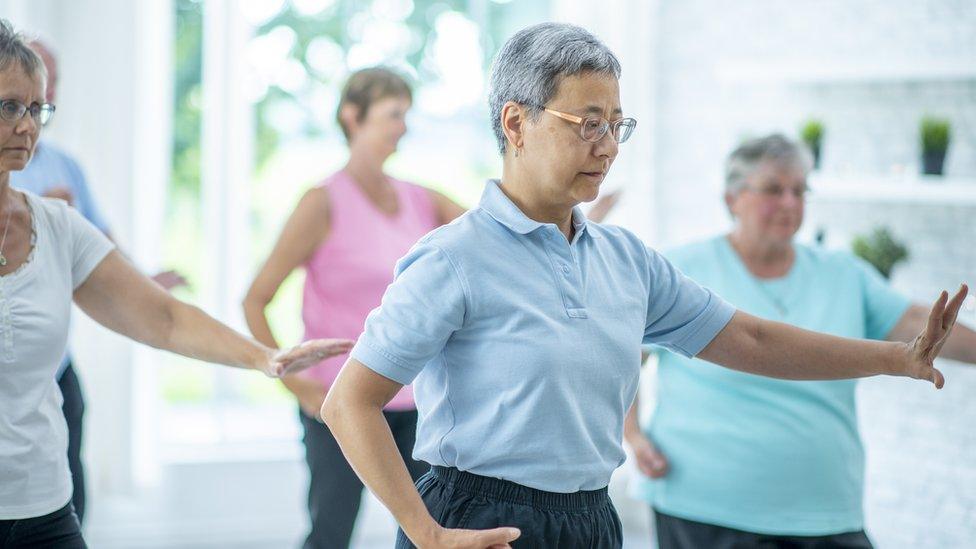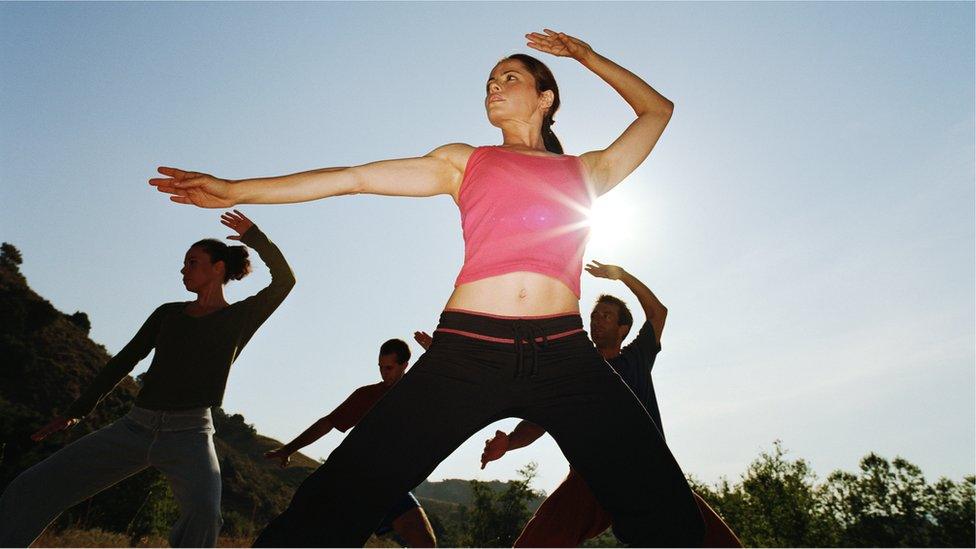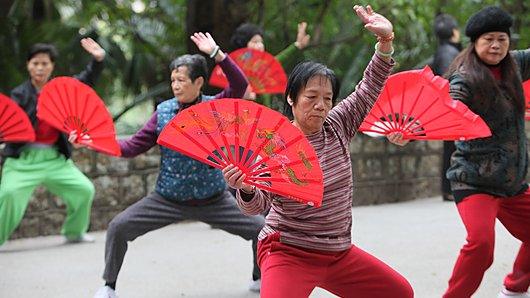Strengthen muscles as well as heart to stay fit and healthy, say top doctors
- Published

The ancient art of Tai Chi combines deep breathing and relaxation with gentle movements
Adults are advised to do muscle-strengthening exercises twice a week, as well as aerobic exercise, to help them stay active for longer, under new guidance from the UK's top doctors.
For the first time, it includes advice on safe activity levels for pregnant women and new mums.
Dance, bowls or Tai Chi are advised for over-65s to reduce falls in old age.
Physical activity protects against obesity, type 2 diabetes, heart disease and depression, the advice says.
The new guidelines on physical activity have been produced by the UK's chief medical officers and updated to reflect the latest scientific evidence.
Their message is that any activity is better than none, and more is even better.
Prof Dame Sally Davies, England's chief medical officer, said most children and adults in the UK are not active enough.
"We need more active travel, we need people to get off the bus or the tube a stop early.
"We need people to climb stairs instead of getting in a lift...
"We need to be more active."
The guidelines recommend that adults build strength and balance to help stave off the natural decline in muscle mass and bone density that starts around the age of 50.


Babies should have 30 minutes of tummy time when awake every day
What is recommended in the guidelines?
For under-5s
infants - 30 mins of tummy time - when the baby is on its front - for infants not yet mobile every day
toddlers - 180 minutes per day doing active play
pre-schoolers - 180 minutes per day of physical activity, including at least 60 mins of moderate to vigorous exercise
For 5-18 year olds
at least one hour of moderate to vigorous physical activity per day across the week, such as PE, active travel, after-school activities and sport.
develop muscle fitness and bone strength
minimise time spent being sedentary
For 19-64 year olds
aim to be physically active every day
develop or maintain strength of muscles by doing heavy gardening, carrying heavy shopping or resistance exercise - 2 days a week
at least 150 minutes of activity, such as brisk walking or cycling, or 75 minutes of vigorous activity like running each week
minimise time spent being sedentary - break up long periods of inactivity

Heavy gardening is one way of strengthening adult muscles
For over-65s
some physical activity is better than none
on two days a week, activity to improve muscle strength, balance and flexibility, including Tai Chi, dance, bowls and aqua-aerobics
each week, 150 minutes of moderate-intensity aerobic activity, building up gradually
break up prolonged periods of being sedentary with light activity when possible, at least with standing
For pregnant women
aim for 150 minutes of moderate-intensity activity every week
vigorous activity is not recommended for women who were previously inactive
don't bump the bump
do muscle strengthening activities twice a week
For after childbirth
aim to build up to 150 minutes of activity every week
build up to muscle strengthening twice a week
start daily pelvic floor exercises as soon as you can
For disabled adults
physical activity is not a risk and brings similar benefits to the rest of the adult population

Tim Hollingsworth, from Sport England, said it was great to see the strength and balance exercises on a similar footing to cardiovascular exercise.
"The beauty of it is there are many ways to build strength and balance, whether it's at home, at the gym or through sport.
"Resistance training, circuit training, racquet sports and yoga are all great, for example, for improving muscle function, bone health and balance."
Dr Max Davie, from the Royal College of Paediatrics and Child Health, said families must try to build exercise into daily routines by walking or cycling to school, for example.
"We know that by doing so, it can have major mental and physical health benefits for their growing child both now and in the future," he said.
- Published10 October 2018

- Published18 September 2015
